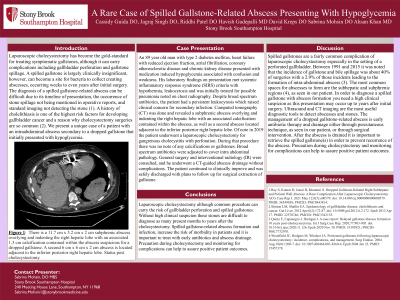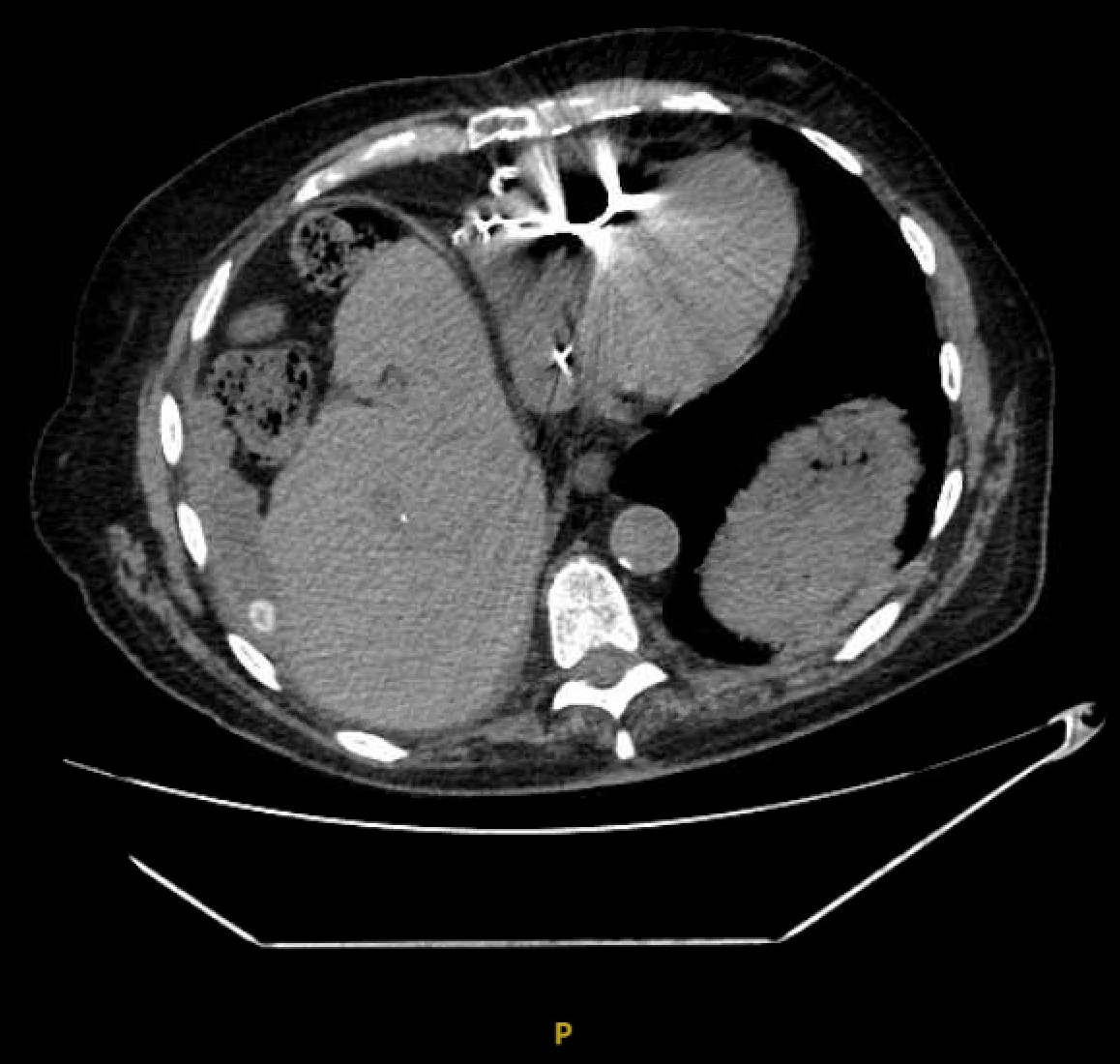Monday Poster Session
Category: Biliary/Pancreas
P1512 - A Rare Case of Spilled Gallstone-Related Abscess Presenting With Hypoglycemia
Monday, October 23, 2023
10:30 AM - 4:15 PM PT
Location: Exhibit Hall

Has Audio

Sabrina Mohsin, DO
Southampton Stony Brook
Southamtpon, NY
Presenting Author(s)
Cassidy Guida, DO1, Jagraj Singh, DO1, Riddhi Patel, DO1, Havish Gadepalli, MD1, David Kreps, DO1, Sabrina Mohsin, DO2
1Southampton Stony Brook, Southampton, NY; 2Southampton Stony Brook, Southamtpon, NY
Introduction: Laparoscopic cholecystectomy has become the gold-standard for treating symptomatic gallstones, although it can carry complications including gallbladder perforation and gallstone spillage. A spilled gallstone is largely clinically insignificant, however, can become a site for bacteria to collect creating abscesses, occurring weeks to even years after initial surgery. We present a unique case of a patient with an intraabdominal abscess secondary to a dropped gallstone that initially presented with hypoglycemia.
Case Description/Methods: An 89 year old man with type 2 diabetes mellitus, heart failure with reduced ejection fraction, atrial fibrillation, coronary atherosclerotic disease and chronic kidney disease presented with medication induced hypoglycemia associated with confusion and weakness. His laboratory findings on presentation met SIRS criteria with hypothermia, leukocytosis and was initially treated for possible pneumonia noted on chest radiography. Despite broad spectrum antibiotics, the patient had a persistent leukocytosis which raised clinical concern for secondary infection. Computed tomography (CT) was done and revealed a subphrenic abscess overlying and indenting the right hepatic lobe with an associated calcification contained within the abscess, as well as a second abscess located adjacent to the inferior posterior right hepatic lobe. In 2019 the patient underwent a laparoscopic cholecystectomy for gangrenous cholecystitis with perforation, without note of any calcifications or gallstones. Broad spectrum antibiotics were adjusted to cover intra abdominal pathology. General surgery and interventional radiology (IR) were consulted and he underwent a CT-guided abscess drainage without complications. The patient continued to clinically improve and was safely discharged with plans to follow up for surgical extraction of gallstone.
Discussion: Spilled gallstones are a fairly common complication of laparoscopic cholecystectomy especially in the setting of a perforated gallbladder. The most common spaces for abscesses to form are the subhepatic and subphrenic regions, as seen in our patient. The management of a dropped gallstone-related abscess is early antibiotic therapy and drainage either through percutaneous technique, as seen in our patient, or through surgical intervention. Precaution during cholecystectomy and monitoring for complications can help to assure positive patient outcomes.

Disclosures:
Cassidy Guida, DO1, Jagraj Singh, DO1, Riddhi Patel, DO1, Havish Gadepalli, MD1, David Kreps, DO1, Sabrina Mohsin, DO2. P1512 - A Rare Case of Spilled Gallstone-Related Abscess Presenting With Hypoglycemia, ACG 2023 Annual Scientific Meeting Abstracts. Vancouver, BC, Canada: American College of Gastroenterology.
1Southampton Stony Brook, Southampton, NY; 2Southampton Stony Brook, Southamtpon, NY
Introduction: Laparoscopic cholecystectomy has become the gold-standard for treating symptomatic gallstones, although it can carry complications including gallbladder perforation and gallstone spillage. A spilled gallstone is largely clinically insignificant, however, can become a site for bacteria to collect creating abscesses, occurring weeks to even years after initial surgery. We present a unique case of a patient with an intraabdominal abscess secondary to a dropped gallstone that initially presented with hypoglycemia.
Case Description/Methods: An 89 year old man with type 2 diabetes mellitus, heart failure with reduced ejection fraction, atrial fibrillation, coronary atherosclerotic disease and chronic kidney disease presented with medication induced hypoglycemia associated with confusion and weakness. His laboratory findings on presentation met SIRS criteria with hypothermia, leukocytosis and was initially treated for possible pneumonia noted on chest radiography. Despite broad spectrum antibiotics, the patient had a persistent leukocytosis which raised clinical concern for secondary infection. Computed tomography (CT) was done and revealed a subphrenic abscess overlying and indenting the right hepatic lobe with an associated calcification contained within the abscess, as well as a second abscess located adjacent to the inferior posterior right hepatic lobe. In 2019 the patient underwent a laparoscopic cholecystectomy for gangrenous cholecystitis with perforation, without note of any calcifications or gallstones. Broad spectrum antibiotics were adjusted to cover intra abdominal pathology. General surgery and interventional radiology (IR) were consulted and he underwent a CT-guided abscess drainage without complications. The patient continued to clinically improve and was safely discharged with plans to follow up for surgical extraction of gallstone.
Discussion: Spilled gallstones are a fairly common complication of laparoscopic cholecystectomy especially in the setting of a perforated gallbladder. The most common spaces for abscesses to form are the subhepatic and subphrenic regions, as seen in our patient. The management of a dropped gallstone-related abscess is early antibiotic therapy and drainage either through percutaneous technique, as seen in our patient, or through surgical intervention. Precaution during cholecystectomy and monitoring for complications can help to assure positive patient outcomes.

Figure: A CT non contrast abdomen showing 11.7cm x 5.2cm x 2cm subphrenic abscess overlying and indenting the right hepatic lobe with an associated 1.3cm calcification contained within the abscess suspicious for a dropped gallstone.
Disclosures:
Cassidy Guida indicated no relevant financial relationships.
Jagraj Singh indicated no relevant financial relationships.
Riddhi Patel indicated no relevant financial relationships.
Havish Gadepalli indicated no relevant financial relationships.
David Kreps indicated no relevant financial relationships.
Sabrina Mohsin indicated no relevant financial relationships.
Cassidy Guida, DO1, Jagraj Singh, DO1, Riddhi Patel, DO1, Havish Gadepalli, MD1, David Kreps, DO1, Sabrina Mohsin, DO2. P1512 - A Rare Case of Spilled Gallstone-Related Abscess Presenting With Hypoglycemia, ACG 2023 Annual Scientific Meeting Abstracts. Vancouver, BC, Canada: American College of Gastroenterology.
